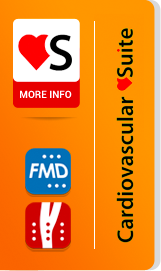
The Carotid Intima Media Thickness, also known as IMT is defined as the distance between the lumen-intima and the media-adventitia interfaces and it is an early biomarker of cardiovascular disease and increasing cardiovascular risk.
The IMT is a demanding measurement because its medium value typically lies around 550 micrometers on images of 100 micrometers resolution.
This value is automatically obtained thanks to an innovative edge detector, powered by Quipu, applied on B-mode ultrasound images of the vessell.
Thank to Quipu’s subpixel edge detector algorithm the typical image resolution limits can be overcome.
In fact, Quipu’s innovative mathematical operator can reach a subpixel precision (i.e. 20 micrometers) in IMT measurements (ref).
Carotid Intima Media Thickness is included as sub-clinical target organ damage in 2013 ESH-ESC guidelines for risk stratification in hypertensive patients [ref].
Large epidemiological studies (ref 1,2,3,4,5,6,7,8) have consistently reported the predictive value of IMT for myocardial infarction or stroke independent of other traditional cardiovascular risk factors.
Besides the importance of a morphological biomarker such as IMT, big emphasis has been placed also on a functional vascular parameter: Arterial Stiffness.
Local Stiffness at the carotid site (i.e. Carotid stiffness) is a mechanical parameter that can be estimated by instantaneous diameter assessment from B-mode ultrasound in conjunction with local pressure measurement.
Large epidemiological studies (ref. 1,2) have been investigating the relationship between carotid stiffness and different cardiovascular risk factors.
Carotid stiffness was associated with hypertension, diabetes, physical activity and increased cardiovascular risk in patients who already had vascular disease.
The local stiffness evaluation by Carotid Studio has been validated by a comparison with a RF-data based system that is considered the gold-standard technique for its high spatial resolution.
The mentioned paper shows that Carotid Studio is in agreement with the gold-standard device and has similar precision (i.e. reproducibility) (ref).
This page uses cookies. Visiting this website, you approve the use of cookies. For more information, please click on "Show details"
The law states that we can store cookies on your device if they are strictly necessary for the operation of this site. For all other types of cookies we need your permission. This site uses different types of cookies. Some cookies are placed by third party services that appear on our pages. For more info see our Privacy policy.